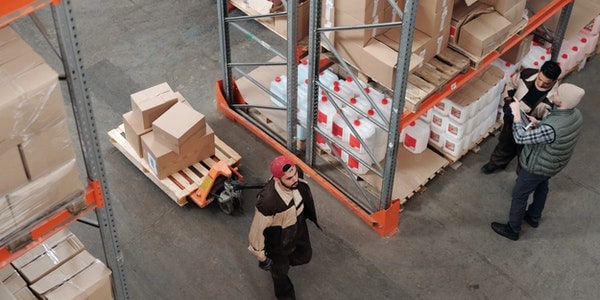Presented by: RS Risk Solutions Ltd
Its vital to avoid taking shortcuts, especially when moving large items at work. Rushing through material handling tasks can easily lead to safety issues and related injuries.
Material Handling Best Practices
When moving large, bulky or heavy items at work (eg boxes, crates, equipment or furniture), its important to keep safety in mind. After all, poor material handling practices can lead to serious injuries, such as struck-by incidents or musculoskeletal disorders. As such, consider these material handling recommendations to avoid accidents at work:
- Wear safety gloves to protect your hands during tasks. Gloves can prevent cuts and scratches; many types also provide a better grip.
- Conserve space in your work area, but do not pile items too close to a wall or column. Instead provide proper clearance at the top and on all sides of piles.
- Pick up items you drop on the floor to prevent possible slip and trip hazards.
- Ensure there are no obstructions or slippery spots on the route you intend to travel before moving an item.
- Use your legs, not your back, when lifting loads. Shift your feet rather than twisting your body when you need to turn.
- Ask for help if a load is so bulky you cannot properly grasp or see around it. Don’t move large items alone.
For more information on safe material handling practices, contact your supervisor.
Safe Driving Guidelines
Safe driving is a crucial responsibility that impacts not only your well-being but also the safety of everyone on the road. It involves recognising and mitigating common driving hazards, such as distractions, speeding, impaired driving, fatigue and adverse weather conditions. Key safe driving practices include defensive driving techniques, regular vehicle maintenance, adherence to company policies and respectful sharing of the road with other users.
Yet, safe driving is not just about following rules; it’s a conscious choice that can prevent accidents, save lives, and reduce the economic and personal costs associated with road incidents. It’s a shared responsibility that extends beyond the workplace, making the roads safer for all. Use these safety tips to help prevent accidents and stay safe while driving for work:
- Stay focused. Keep your attention on the road and avoid distractions like texting, talking on the phone, eating and using in-car entertainment systems while driving.
- Obey speed limits. Adhere to posted speed limits and reduce your speed in adverse weather conditions or areas with heavy pedestrian or cyclist traffic.
- Maintain a safe following distance. Follow the “two second rule” to maintain a safe distance from the vehicle in front of you. Increase your following distance in adverse conditions.
- Use your indicators. Always use your indicators to make tour intentions clear when changing lanes or making turns. This helps other drivers anticipate your actions.
- Stay sober. Never drive under the influence of alcohol, drugs or substances that impair your judgement or reaction times.
- Wear seat belts. Ensure all occupants in your vehicle wear seat belts at all times. Seat belts significantly reduce the risk of injury in accidents.
- Manage fatigue. Avoid driving when you’re tired or drowsy. Take regular breaks on long journeys to stay alert.
- Adapt to weather conditions. Adjust your driving speed and style to match current weather conditions such as rain, snow or fog.
- Check blind spots. Be diligent in checking your blind spots before changing lanes or merging into traffic.
- Observe traffic rules. Follow all traffic signs, signals and rules of the road. This includes stopping at stop signs, obeying traffic lights and yielding to drivers who have the right or way.
- Maintain your vehicle. Regularly inspect and maintain your vehicle. Ensure brakes, tyres, lights and other critical components are in good working order.
- Be patient. Exercise patience, especially in heavy traffic or when dealing with slower-moving vehicles. Aggressive driving can lead to accidents.
- Watch for pedestrians and cyclists. Be vigilant at pedestrian crossings and junctions, and always yield to pedestrians. Give cyclists adequate space when passing them.
- Avoid distractions. Keep conversations and activities with passengers to a minimum. Use hands-free devices for phone calls.
- Plan your route. Plan your journey in advance, especially for long trips. Know your route, alternative routes and motorway service stations.
- Stay informed. Stay updated on traffic and weather conditions and be prepared for unexpected road closures and detours.
For any questions regarding safe driving, speak with your supervisor.

